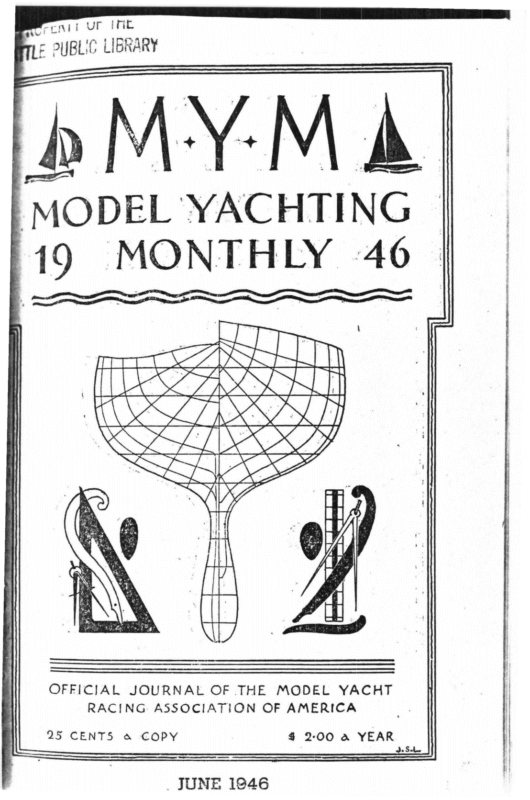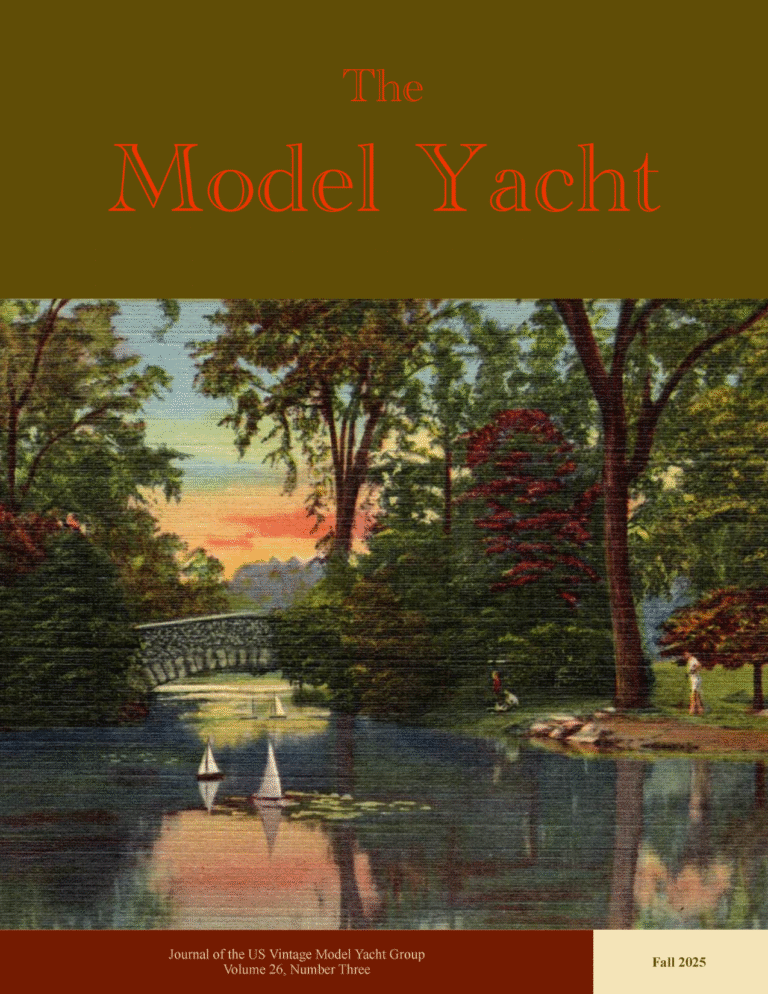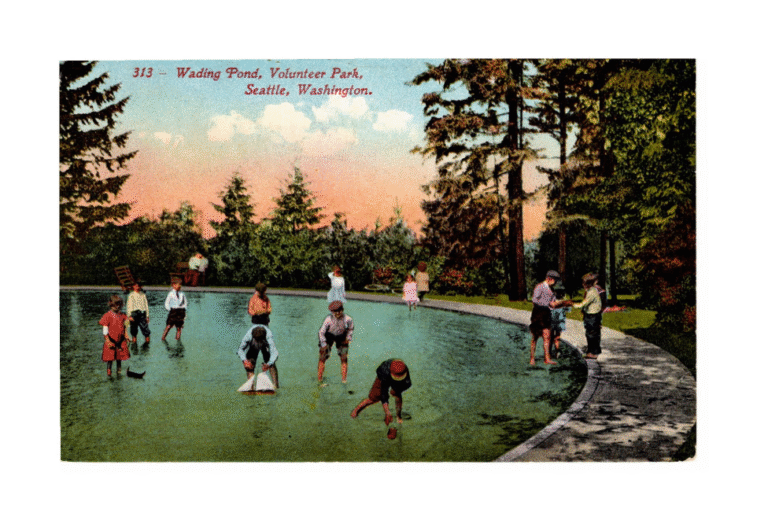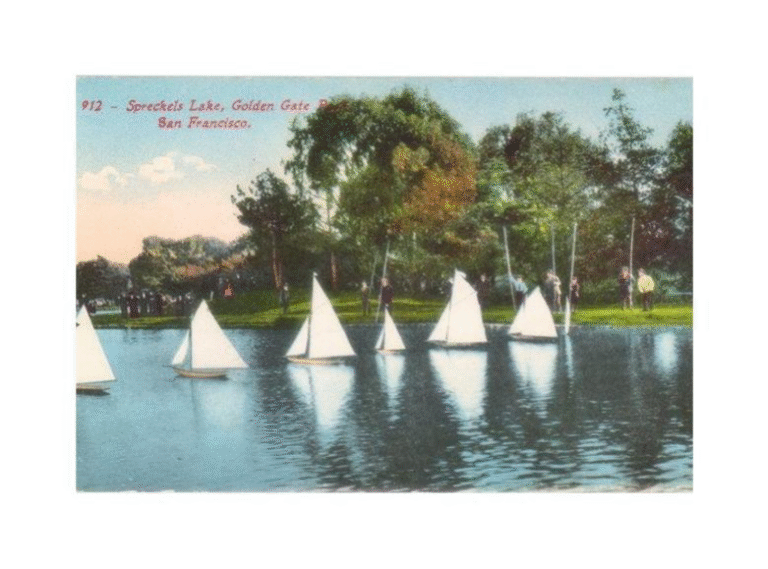- Feature Article: Speed Factors of Model Racing Yachts
- Key Points: Speed depends on hull shape, wetted surface, and resistance
- Speed-length ratio for models can reach 2.4 (higher than major yachts)
- Hull design considerations:
- Round midship section = easy to drive, good stability
- V-section = fast running, poor windward performance
- Wide shallow section = fast in light weather
- Sharpie section = easy to build, less competitive
- Balance critical: fore and aft trim must remain true under heel
- Coefficients used in design: midship, block, prismatic
- Curve of areas should follow Colin Archer theory for low resistance
- Practical Tips
- Blueprint Accuracy:
- Blueprints may shrink or distort; always check station spacing and dimensions
- Use table of offsets for precision
- Plastic Hulls:
- Styrene with fiberglass laminations suggested for low-cost hulls
- Weldwood glue recommended for planking
- Mosquito & Weed Control in Ponds:
- Bluestone treatment effective for algae
- Sticklebacks help control mosquito larvae

. , c1′, r ur I nt I UBL:C LIBl~ARY .MODEL ‘YA’CH:TfNG 19 ;MONTH·LY ..46 • 1 I; OFFICIAL JOURNAL RACING- OF .THE MODEL ASSOCIATION OF ’25 CE.NT 5 o. ·COPY YACHT AMER.rCA t 2·00 a YEAR .,. s.t- _ JUNE 1946
MODEL YACHT RACING OF AMERICA 1921 ~ The object of this Association is to encourage and promote the duigning, buildin&’, and racing of model ailing yachts, and to establish uni:form rules and regulatioru1 for the conduct of the sport. Model yacht clubs in the United States or possessions having a roster of not less than ten members are eligible for membership in the M. Y. R. A. A. Annual dues are ten dollars. Applications for membership shall be made in writing to the National Secretary, and shall be signed by the Commodore and Secretary of the applicant club, stating the number of members the applicant club has, and accompanied by a fee of ten dollar!, as dues for the calendar to be returned if the application la jected. ‘ A model yacht competing in anr tional, Divisional or Invitation R must be registered in the M. Y. R. Member club! are grouped in di • the Eastern, Mid-western, and P ‘ andare units forming the M. Y. R. Ea~ division h~s it.a own regi~nal cers and divisional championship The National . Aasociation has charge of the National Champio and other National Race8, and pro gates Rules and Regulations for the duct of the sport. NATIONAL OFFICERS AND EXECUTIVE COMMITTEE Charles He-isler, President 234 State Street, Albany. N. Y. • H. H. Howeler, Vice President 5730 Drexel Avenue. Chicago 37, Ill. Wilmarth F. Post, Treasurer 3054 Coleridge Rd., Cleveland Hgts. 11, Ohio Freeman J. Santos, Secretary 71 Calla Street, Providence, R. I. J. L. Sythoff, E. D. Representative 84-09 Talbot Street, Kew Gardens, L. I., N. Y. Archie Arroll, Mid. West Representative 13428 Glenfield, Detroit, Mich. A. R. Lassell, Pacific Div. Rep,: 831 Lakme Ave., Wilmington, -Calif. EASTERN DIVISION OFFICERS C. A. Heisterkamp, Pres. ‘~ 6814 Clover Lane, Upper Darby, P~. D. J. Manning, Vice-Pres. 41 Osbourne St., Peabody, Mass. A. S. Anderson, Treas. 19 Town Hill Ave., Rumson, N. J. H. L. Curry, Sec’y. . 28 East Ave., Valley Stream, N. Y. MID-WEST DIVISION OFFICERS M. J. Donovan, Pres. 1615 Wendall Ave., Lima, Ohio Ronald B. Meil, Vice-Pres. 4186 Ellison Rd., Cleveland, 21 Archie Arroll, Sec.-Treas. 13428 Glenfield, Detroit, Mich. PACIFIC DIVISION OFFICERS Don Lyon, Pres. , 334 10th Ave., San Francisco, Cal. Frances Rankin, V. Pres. 1889 ·Harmon St., Berkeley, Cal. M Fiare, Sec.-Treas. 7228 4th N. W., Seattle, Wash. I MODEL YACHT RACINC ASSOCIATION OF AMERICA: OFFICIAL PUBLICATIONS Sailing Rules (Pond) and General Rules …… 20c each. Lots of ten or more, 18c Sailing- Rules (Skiff) ……………………. lOc each. Lots of ten or more 8c M-Class Rating Rules (Marblehead 50-800) ….. lOc each. Lots of ten or more, Sc X-Cle.ss Rating Rules (1000 sq. in. S.A.) ……. 1·oc each. Lots of ten or more, Sc Standard Starting Schedules …………….. 20c each. Lots of ten or •more, 18c e Measurement Certificate Blanks …………………….. A-Class, 6-M Class, $1.75 per hundr M. Y. R. A. A. R. Rubber Stamp (to record S.A.) ……………… 50c each, postpa Make check or M.O. payable to W. F. POST, Treasurer, M. Y. R. A. A. u:: 8054 Coleridge Road, Cleveei length ratio of about 2.4 and additio~ power is applied, she is either depreSle( deeper into the water, even to the poij of sinking, or she rises on the surface~ planes. In racing classes where overhangs Ill allowed such as the A.class or the x-ciaaa etc., this condition is eagerly taken al vantage of, as you will see long, lot overhangs at each end of a comparativt. ly, short Water-line. When these boata get going they automatically inc~ their sailing lengtll, so that their spee4 is limited only to the amount of overhan, available. In the M-class there is 11 overhang, no additional length avail~blei the only way to increase Sl)eed in thfa class is to design a yacht that will ~ to the surface and plane. This ma· may not be advisable. • We might mention }lere that the fest hull form up to .this critical ·point speed, is the one that offers the· 1east sistance to forward motion as. a •dft. placement vessel.·· • That is;• the Ieait wetted . surf ace,. the • least wave resist; ance, least eddy resistance and least ‘Wini .resistance; and be·yond this point of spee4 requires an· entirely,. different hull f<>?lll! .It. is the atmospheric pressure • tbaf causes a boat to be ·depressed deepei into· ..the .water as· it gains speed. To understand· how this works, turn on. faucet in •the sink until you have smooth flow of water. Hold a spoon the handle so that the bottom Just touci; es the water. What happens? ‘l)j spoon is sucked into the stream. If ~ turn the water on faster the spoon I sucked in more violently. Now take knife and hold the flat surface aga’ the stream. There is only capilfary a£:; traction that has any tendency to hold the lmife, but turn the water on faster and the force tmshes the lmife awa , Now take a piece of sheet metal about an inch wide and bend it slightly length• wise and place it on the flow of waterJ and you will notice suction .again. In the design and construction of model yachts, speed is the most sought for characteristic by both designer and builder. One would imagine that if the principles of speed were understood that there would be only one “best shape” for racing models, and that all models would be proportional. Every skipper would like to own a “good, all-round boat”, but there is no such thing if the accent is placed on “good”. You might think there were some by the records made by certain skippers who constantly sail off with. all the trophies. Actually they have a design that fits nicely into the averag-e conditions on their race course. They have taken all the kink out, and the boat is sailed bv an expert. Quite a lot of experimental work has been done with different shapes, and the conclusion established is that certain shapes are better for certain conditions, but there is no “best” for all conditions. There are certain things that make for speed, while the opposite is desired.for sea-worthiness, and as we must have a proportion of each in a model it is up to the designer how much of each wil be employed~ There are some shapes. that are· best for speed in light weather, 11nd the oposite hold for heavy weather. Again we have the .old traditional compromise.. Understanding your boat and knowing what to do and how to do it, wins races. Be that as it may, the boat is at lea~n. 60% of the battle, so we will examille different shapes, and try to determine the characteristics of each. In almost every book on naval architecture one is reminded of the fact that lenJ;?th is necessary for speed, and that the sneed of a displacment vessel is limited to its sailing length or speed-length ratio. Few major yachts have a speedlength Fatio of more than 1.25, although exceptions are when a yacht planes, when the sneed-length ratio may be as high as 1.50. • This applies to major yachts, but model racing- yachts have reached a speedleng-th radio of 2.4 in actual sailing. (V 2.4 V L, Velocity=2.4 times the square root of the L WL.) Let us examine our popular M-class, which has an overall limit of 50 inches. The fastest boats in this class have taken advantage of the rule and the L WL has been made eaual to the LOA. Using the above formula, V=2.4 VL we find that the maximum speed for a displacement boat of this length to be 4.9 lmots. · Ho,w . THE MIDSHIP SECTION The midship section, or master section is the principal factor governing the shape of the whole boat, and is the fir&t . 2
them hard to drive in light winds. They are not slow by any means, and given a good breeze they will make a fine showing. For junior clubs the sharpie is an ideal type of boat, and can be constructed easily by boys of 15 years . • the boat to be considered when In order to know what type dc·’.~!1.;:~g.may be deve~oped fro~ a cero< ••1\. pe of midsection, requires contn 111 .\j~ experience. However, there are 11.!,·r.i •haracteristics that are known to .,,nit' l • h ··t11certain s apes. par! ,,t J•' I\ ENTRY AND DELIVERY As a yacht moves through the water, the forward part of the boat must displace the water in the trough in which it sails. The after part must let the water back gradually. Thus the forebody is often referred to as the "entry", and the after-body the delivery". The way in which this water is displaced by the forebody is a direct indication as to the boat's performance. Therefore it is necessarv to have the fore and after parts balan'ced so there is an even· rate of displacement from the forward point of immersion to the middle-body, and a gradual delivery to the stern. When sailin~ at moderate speed the hull should leave the water undisturbed. If the bow is too full. the water is piled up before the middle body 'is reached, and if too fine, the middle body has too much work to push the water aside. It has been found that the best form for the hull is to have the fore body longer than· the afterbody. This will be taken up later when we discuss the curve of areas, where we find that about 55% LWL is average for the fore part. • I TYPES OF MIDSHIP SECTIONS F · 1 we have a round type of sec111 . t has been used for years in all t•:•:;.... of craft. It is e~sy to drive, _s~at> 1 • \’ maintains considerable stability, 1 ‘ w,,rt 1·: • easy m a seaway. Alth oug h a 11 1 1 • ~ t clesigned from this type of midsec1 ~•· \. ·11heel readily to its sailing angle, 1 1 t1<>ll • 1Y st”ff it O ·omes increasing 1 th e more 1·t is h~~led. As the_ s~ape ?f this sect_io~ ,proaches a sem1-c1rcle 1t has a mmi11 of wetted surface. These are the mt 1i 11 desir~ • d m • a racm~ • yac_ht , characteristics this type of section or a mod1ficat10n 10 of it should do very well. Fi~ 2 shows the V-section. This type of boat, although very fast running, is not a good boat for windward work, and 111 a poor boat in a sea. In the first place It heels easily, and is very weak, due to the fact that the ends of the boat will have very little reserve buoyancy, hence ll•ss stability. The fact that the V-shape ls a good feature when running, is the rl•ason that many ·boats have the bottom of the hull in the form of a wide V from the garboard almost to the turn of the bil~c. thus incorporating into the design as much of this feature as is deemed adl’isable. Pig. 3. This section is the wide, shallow section which is very fast in light WPather, and shows, un well under average conditions when not heeled to any great extent. A boat designed from this type of midsection carries its sail well, which sometimes steadies it. It is generallv considered a light displacment type and can be designed with very shallow buttocks. The beam being greater than in Fig. 1 it has lots of initial stability, but as the going gets rough, a shane more like Fig. 1 will drive easier as it has less wetted surface anrl is easier in a srawav. In general the shallow section contains the elements of speed to a higher dt!gree than a narrower or more V-shaped section. Midshin sections varying all thP. “‘:lv from the shape in Fig. 1 to that of F 1s.r,.3 havP. been used rnccessfully in the des1~n of racing models. . Fig. 4 shows the typical “sharpie” section. Although this type of boat is eac;v to construct it is not very pooular among models. as the majority of round-bottomed boats out-sail them under averal?’e conditions, as the sharpie has more we.tted surface, and the hard bilge makes h’;t BALANCE Unless a yacht holds her fore and aft trim under every angle of heel, she will refuse to hold a true course; so it must’ .be considered that the shaoe of the hull is altered at every angle of heel, that the top-side as well as the under-water part must be regarded as a whole, and balanced accordingly. In models where overhangs are not limited. the forward and after overhang-s are each equal to about 20% of the L WL. The ends are keot low, so that as much sailing- length as possible is available when the yacht is heeled. Also there is not t.he problem c,f reserve buoyancy anci stability that there is when overall length is limited as in the M-class. In this class of yachts the main fault of many designs has been the pinchingin at th’e bow. This lack of buoyancy at the bow, not corresponding with that at the stern, throws the center of buoyancy of the whole boat AFr when heeled. causil1 bore, or be down at the 11.ead. This sets us <\twisting- effect that forces the head into the wind. On the other hand if the bow were too full. the bow would be thrown out of thf' w~ter, causing her to run off the wind. This point 3
limited as far as possible. Since surf8'1 resistance is probably over 50% of th. total resistance of a sailing- yacht, the surface and finish of the hull is of prinie importance. Any irregularities in ~ hull should be avoided, as any shape that diverts or obstructs the smooth flow of water around the hull offers serious. re. sistance in the form of eddies. The wetted surface should be keot at a mini. mum, with a hard, smooth finish. is very important, and is the most common error in designs by beginners. So before you finish with a design, check the upright and heeled C. B. ( Center of buoyancy) and if they are not in the same place you must adjust the f or~ard or after sections, or both. The easiest way to do this is to change the ends of the lower diagonals that affect the forward and after quarters, and correct the sections affected. Changing the deck line may also be necessary. The error allowable between the heeled and the upright C. G. is said to be five one-hundredths of the LWL. That is, if the L WL is 50 inches, the maximum error allowable is one quarter of an inch. CO-EFFICIENTS ·The fineness of a hull is generally judg-ed by three co-efficients: The midship·-section co-efficient, ( Cx) which is the ratio of the area of the midship section to a circumscribed rectangle, The Block Co-efficient (Cb) the ratio of the volume of displacement to that of a circumscribed block. The Prismatic Co~efficient ( Cp) the ratio of the volume of displacement to that of· a solid whose length is equal to the L WL and whose cross-section areas is equal to that of the midship section. The latter is the most important, and is used in many ways. •It is often one of the first :figures decided on and. is used to compute the possible 'displacement. The use of thes co-efficients does hot mean a ~reat deal to anyone until thev have had an opportunity to compare a. number of models. The Prismatic efficient for models generally is between .50 and .56. A~ an example in the use ·of this co-effi&ient to determine the pro~ able amount of displacement of a canoe bota. 5 has 6. 00 sq. rn., {t1r that station, etc. • it ha~ ~r 1 • • Draw a fair curve through these points, which shows the curve of areas. If you have to force the batten so that it causes irregularities, the area at that point needs adjusting. There are a good many boats whose curve of areas does not agree with the Colin Archer theory, but it IS a low resistance curve, and one would do well to use a curve that resembles it Foremost of all, the curve must be fair and sweet, with an even rate of entrance and delivery’. Many designers draw the curve of areas first, and make each section conform to it, but that is just another way of designing. L I ————- Bits of Oakum From Here and There The center of lateral plane of a yacht should be located in terms or water-line length. A distance of between 54% and 5!)% is considered about right. Rating Rules, intended to keep yachts of any class more or less equal in speed for good competition, always work out so that original boats built under the rule increase •ni size and weight in spite of Wind tunnel tests prove that on a beat, the rules. Hence the A-Class haS” done pressure increases near the luff dr a sail, just this, as lhave the Swedish Sq. and ~ecreases rapidly towards the luff, Metres Classes. Displacement of the reaching a value of nearly zero’ at the latter has nearly doubled in twenty years ~fter edge. Thus practically all the drivand L WL taken a big increase. Sailmg- force is obtained from that portion plans have grown heavenward and given of the sail nearest the luff. increased effici~ncy. The new, heavy boats are faster than the old light types ~hen casting lead keel in plaster of in all weathers. A limit on hoist of sail~ans,. or gypsum as it really is, mix sol””‘P. plan prevents the A- and 6-M Class from eer m the water, and the mixture will gaining the advantage of increased not set so rapidly. speed.
-MODEL YACHTING IN PORTUGAL Mr. Joao Pereira de Freitas, Rua do Quelhas, 25 r/c Lisbon, Portugal, is an ardent fan, and the pioneer of the sport in Portugal. He is director of an insurance company and sails evenings and week-ends on a little lake 60×80 metres beside the Tagus estuary. The lake, named “Espelho de Agua, or ”Water-mirror, suffers from poor wind conditions caused by buildings. The Tagus Estuary has a strong tide, and suitable skiffs are unavailable. Mr.· Freitas tells us that the Portuguese models are small, the largest being the C. N. P. Class, 1.1 metre LOA, or 43.3″. His first boat was “Nalita,” 0.9 Metres about (36″) a g3ff rigged cutter, which attracted much attention, and induced other amateurs to build during 1944, some of them a bit larger, but not e~ceeding 1.06 Metres LOA, being made as he states “ad hoc,” or without using any particular design. Meanwhile,. a Portuguese Nautical organization (Club Nautico de Portugal) became interested and have created a new Section devoted to model yachting. Existing boats were placed in three Classes, “free, or open,” and are described by Mr. Freitas as follows: FREE CLASSES: C: no more than 0.75 metres 0. A. B: no more than 0.76 to 0.95 A: no more than 0.96 to 1.06 NEW CLASS. C. N. P. Class. 1.1 metres, no allowance in length) 0.22 to 0.25 beam; 1.65 highest sail plan. Hence the C class would. be 29.5″ LOA, the B-Class, not more than 37.3,” A-Class up to about 40 inches. “These little boats,” writes Mr. Freitas, sailed in several regattas, with silver cups for prizes. Of these I have collected 12, won by bread-and-butter and dug-outs, “Marilena,” “Gaviao” • and. “Perdigao,” all Free A-class boats. . 6 up to the summer of 1945 being the speediest Portuguese boats, with gen. eral lines as those of “Almary” plan ir. MYM, but with unconventional deck and topside lines with the greatcS1 beam forward of the mast-step. The boats of the C. N. P. Class, with ap. proximate lines as the Internationa: A-Class are at present under trial, and are expected to enter regattas in 1946. I have already made two of these boats, the “Lisboa” and “Rada-r,” hav. ing the deck lines of “Perdigao.” I think, however, that this beats the newest brothers Re. steering gearsI not withstanding the Braine system and the U. S. A. Vane being known here, we use the easy controlled system of Rudder surcharged, over the deck by sliding a lead ball fitted on an inverted tiller betwc:en two rubber rings. I have an improvement of the swing rudder with pivot, forked arm and tiller. We are trying to obtain from the Portuguese Government a real model yacht pond. I am going to try to plank an M-Class from the article in MYM which class reminds me of a dingy! I’ will name her “Dandy.”
·”‘EATTLE PUBUL YACHTING JUNE, ~ONTHL Y NO. 16 1946 published Monthly by Tll E MODEL YACHT RACING . ssocIATION OF AMERICA .\ c. H. FARLEY, Editor, 97 Quincy St., Medford, Mass. • ::.OO in Subscription, One Year, Canada: $2.50 Foreign u.s. and i”/ho is the guy Ra.eking a. boat? A wonderful tub, The fastest afloat! , . ht• reeened. Nothing that appears in this A1•. “‘- rnay be repro d uce d, et’th er w h olly or 1n ‘ par t , •• ,,.,ce itten permiuion of the Editor acting for the .,t~·JUI ,rr • or from a contributor who reserves his rights. IIYJlA,- :.·/hat do ya say! Tell us his name So it can get In the hall of fame. .t<0LL OF PATRONS Ains Ballantyne Pireon F. J. Santos !JYC i':·ni'l: :.Gwinn Jr. Deeper Hudson i'.YC Harry Richardson p• n !i:: :.YC Chica~o M.Y.C. ·,n nrn .JivisTon fr,, 1 •n·:.·l.ir J• careful builders' Hearts must bleed To see the way He does the deed! ROLL OF SPO!lSORS Ii"''· .... •tlles C.P. B .l. ‘!illians ·;;ar. B Kraner Q.C. B P. Gordinier Irv. V T. :r rshall \,ar. B B. Blnder s.J. B H. Guy S .J. B .tr. ,Jillians ·.iar. B OD was Frank Snow, So. J. started 10.30, finished 4.30. Br.R.a.m. & Cl.R.3-5 Miles. p.n.Run&:i:3eat, 7~10 miles. T~ FOSTER, Sec .itetropol. –THE DEAD LINE-. A “dead line” in printer’s ‘te. means the date or time after no additional printed matter ca printed in any particular issue. we are supposed to have a dead on the FIFTH of each month,so if send in any news AFTER the fifth the □ onth it will be a miracle 1 appears in the current issue. ·-·. Please try and se news, race reports other matter of imn iate interest as as possible, so won’t be disappof and h:.ve to wait another month be the item 8ets in SAL::O. 3I:RGE of 1.1rimstad, _;orway, has completed a new A-Class desif,n. as well as a new X and a new Six~ i1 design. • K\ROLD SHELL2~H writes that “It looks as if the ;;etropolitan League will sta~e some interclub conte~ts again this year, re 6 a±ning sane prewar acti•.rity. CAPT.. VAN NAEE, our senior Member says “Let’s go:” He’ll take care of th~ competition. Treasurer U.F.POST reports up clubs by the end of April, ~7e hear that are doinp; ,1ell slippery” rigs. Jil [ \l’\P.RELL :vi th their A ~y sez that FREE!’.ANJ. is \’TI’l.tine up the history Rhode Island EYC. llYlI expects to present ne\v desi~s tor the 13-::etres class by c.J.?RATT, _Jancouver r.:Yc, R •.!J.::A.THEso;1, .. ontreal •.:Ye and H .RICHARDSON’ _.:ye. 1 Boston ·.-realso intend to publish several X and U-Class designs, e.r.ionrr these 3 bjT J .SEL=’.!i:R-LARSEN,~’.arbl;head ;:yo. A-C1ass dePi~ns seen to be rather scarce–at least for publishing ….. Surely sone generous desir,ner should coqe to the fore? ~lease Officers notice list of on inside cover of lIYll. A “wolf” knows all the a.n.”l{les. A Pink Elephant is a beast bourbon. 16




